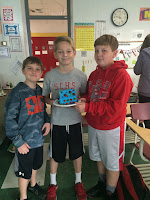This week in class (hours 2, 4-6), we learned to add and subtract decimals. To begin with, students were asked what is IMPORTANT to know when adding and subtracting decimals? With their answers, we created rules...
Rules for Addition & Subtraction of Decimals
1.) Line up your decimals.
2.) Add zeros after the decimal point so that all of the numbers have the same number of places after the decimal.
3.) Add/Subtract as you would with whole numbers.
4.) Just move the decimal point straight down in your answer.
Throughout the week, the student had plenty of opportunities to practice addition and subtraction. Below are the assessments the students did this week:

This week in class (hours 3 & 7), we learned to multiply and divide decimals. To begin with, students were asked what is IMPORTANT to know when multiplying and dividing decimals? With their answers, we created rules...
Rules for Multiplication of Decimals
1.) Line up your numbers with the last digits under each other.
2.) Multiply as you would with whole numbers.
3.) Add the decimal places in each of the numbers being multiplied.
4.) Move the decimal point to the LEFT the TOTAL number of places in the numbers being multiplied.
Rules for Division of Decimals
1.) Move the decimal point in the divisor (the number on the outside of the division house) to the RIGHT to make it a whole number.
2.) Move the decimal point in the dividend (the number on the inside of the division house) to the right the number of places you moved the decimal on the outside.
3.) Divide as you would with whole numbers.
4.) Move the decimal point in the Quotient (your answer) directly above the decimal point you moved in the dividend.


Throughout the week, the student had of opportunities to practice multiplication and division of decimals. Below are the assessments the students did this week:

All classes also took an assessment on Mastery Connect. The students were assessed on addition and subtraction of decimals.
CCSS.MATH.CONTENT.6.NS.B.3 Fluently add, subtract, multiply, and divide multi-digit decimals using the standard algorithm for each operation.
Through Mastery Connect, teachers can assess core standards, monitor student performance, and report student mastery to parents and administrators.






















































